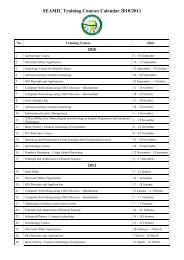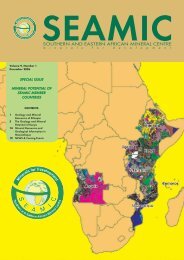SEAMIC Newsletter Vol. 10
SEAMIC Newsletter Vol. 10
SEAMIC Newsletter Vol. 10
Create successful ePaper yourself
Turn your PDF publications into a flip-book with our unique Google optimized e-Paper software.
INVESTING IN ANGOLA'S<br />
MINERAL WEALTH<br />
BY MINISTRY OF GEOLOGY AND MINES OF ANGOLA<br />
BACKGROUND<br />
Angola lies in the south-western side of the African continent.<br />
It is bordered by the Atlantic Ocean to the West, Namibia to<br />
the South, Zambia to the East, and the Democratic Republic<br />
of Congo (DRC) to the North. From west to east, Angola<br />
comprises three physiographic zones: i) Coastal lowlands 50<br />
to 150km wide; ii) North-South striking mountain range<br />
<strong>10</strong>0km wide rising to 2620m above sea level (Mt Moco); iii)<br />
Central highland plateau, at <strong>10</strong>00m to 1500m above sea level,<br />
covering two-thirds of the country.<br />
Angola is actively seeking to attract private local and foreign<br />
investment to its mining sector. Known mineral resources in<br />
Angola are widespread and offer ample investment<br />
opportunities for small and large-scale mining.<br />
Positive factors of primary importance to private investors in the minerals industry include:<br />
♦ political stability<br />
♦ mining legislation<br />
♦ geological provenance<br />
♦ fiscal background<br />
♦ infrastructure<br />
♦ minerals production.<br />
Based on these, Angola's ranking in a global context for multinational inward investment for<br />
mineral development has been well established. It is clear that with the continuing pattern<br />
towards political stability, Angola's geological provenance should put the country in a very<br />
competitive position. Decision making criteria by both exploration and mining companies is<br />
based on such critical issues such as security of tenure, the right to expatriate profits,<br />
management control, equity control and a stable fiscal regime. Some of the positive factors that<br />
catch the attention of investment in exploration and mineral development are discussed below.<br />
GEOLOGY<br />
Angola can be subdivided into 5 main regional geological units, each containing distinct<br />
mineral deposits as discussed below.<br />
Quaternary to Tertiary Sedimentary Rocks comprising sand, quartzitic sandstone, gravel and<br />
clay extend over nearly half of Angola, including the entire eastern part.<br />
Pleistocene to Cretaceous marine sediments lie in a series of coastal basins on the western<br />
margin of Angola.<br />
1




